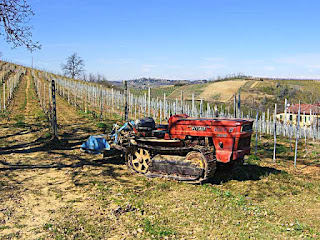 |
| Sonoma County Zinfandel |
 |
| Barbera d'Asti Vineyards |
Alcohol in wines has recently been in the news once again. A consistent trend to pick riper fruit(higher sugar) had resulted over the years in critic approved and consumer accepted fuller bodied wines and typically higher alcohol. Numerous studies have confirmed that many wines have increased in alcohol content by as much as 2% over the last generation from wineries around the globe. It has not been uncommon to see New World wines of California and other warm locals producing white wines in the 14.5 alcohol range, and red wines above 15%! There certainly have been improvements in grape farming and fermentation sciences that may have contributed to this trend. Yet, I'm convinced that wines are made for consumers in consistent 'house styles' so that they are more easily branded for those who enjoy their stylings.
North Coast grape harvests over the last three years have been significantly cool and challenging for growers who have as a result picked less fruit. One of the results of the smaller yields in the face of growing wine consumerism is that grape prices from growers are once again starting to climb(just like farming costs). But the real benefit, according to a SFGate report, is that nature has forced a welcomed change to less robust, more subtle wines with good brightness and acidity. As a result, wines from these most recent California vintages will be lighter in style and (thankfully)lower in alcohol.
 |
| Wine as Foods Companion |
Decanter magazine has recently reported that a growing and significant minority of wine consumers prefer lower alcohol wines. Commissioned by the German wine trade fair, Prowein, the survey of more than 1000 wine drinkers from the US, the UK, Germany and China, indicated they preferred wines of 12% alcohol or less. Perhaps most surprisingly, the low alcohol preferences were markedly higher among the younger adults surveyed.
Those of us old enough to remember pre-1980's table wines saw 11 - 12% alcohol content in wines with regularity. Ultimately, the uniqueness of individual grape varieties and growing environments, farming yields and cellar practices, means that there can be no fixed acceptable level of alcohol in wine. As a complex, living organism made up of organic compounds, good wine will always be the result of correct balance. Alcohol is just one link in the chain that is a wines ultimate balance
 |
| Party-Boy Baby Bacchus |
Recently published studies out of the University of California San Francisco indicate that alcohol is part of a reward-seeking behavior in gnats who are not sexually satisfied. Apparently gnats that have recently mated show little interest in booze, but those that were shunned by lovers may require a more socially rewarding experience, such as alcohol consumption, and choose to consume it.
.
And then my gnat flew back inside the wine glass.
Wine Sips:
- 2009 Tres Ojos, “Old Vine Garnacha,” San Gregorio, Catalonia, Spain
- 2009 Caldora Montepulciano d’Abruzzo, Abruzzo, Italy
- 2010 Santa Julia Reserve Malbec, Mendoza, Argentina
No comments:
Post a Comment